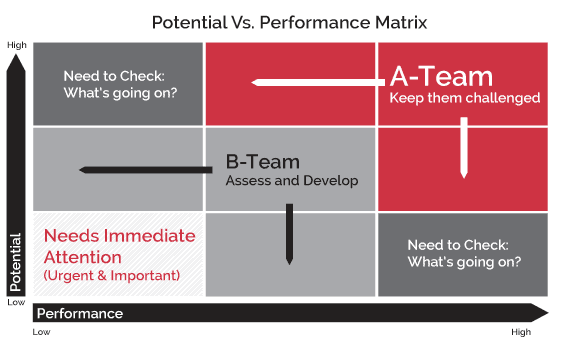
9 Grid: Potential vs. Performance Coaching Template [Video & Guide]
The nine-box performance grid is an assessment tool managers use to evaluate employee performance and growth potential. The grid will give you a quick visual to assess the strengths and weaknesses of your department’s talent. When used collaboratively with HR or your executive team, you can develop long-term strategies to improve your staff.
How Does The Nine-Box Performance Grid Work?
The grid reflects growth or potential on the Y axis and performance on the X axis. By measuring an employee’s development and performance, you can evaluate what the employee needs in a performance plan.
Because the grid gives you an overview of individual team member’s strengths and weaknesses (or room for improvement), you can explore if they are in the proper role and can meet their current responsibilities. If not, do they need reassignment or to be moved out and terminated?

As you can see, the top right corner reflects the “A team” or your top performers. They will need a different type of coaching than those on the lower left. Individuals in this box are the low-level performers who, for whatever reason, are not producing.
Most of your team may fall in between in the “Core Performer” category needing improvement, which could be in skills, attitude, or consistency.
Why Have This Grid?
The benefits of using the nine-box performance grid are that it gives you an overview of what your team needs regarding development. This provides the data to present your case to HR or executive leadership for approval on a professional development plan.
1.) Succession Plan. The overview helps you set up your succession plan to map to your future leaders. The grid enables you to recognize an employee’s strengths and weaknesses and determine what is possible for future roles.
2.) Right Person, Right Role. Are people in the best role for them? As you evaluate where people are, you might explore if someone’s poor performance is because they are not well suited for the role. The grid lets you determine whether employees can meet the job’s expectations or if action is required. For example, if an employee is underperforming, you could move them to another role that better suits their skills or to another department or help them realize the company is not for them and help to move them out.
3.) Establishing performance standards. The potential performance grid helps you set up clear standards to evaluate employees. Using this concept, you can set up those competencies that distinguish a high performer.
4.) Performance tracking. The grid and the evaluation you do with it allow you to coach the employee and map out strengths and weaknesses, along with the plan to improve. This can be used in the coaching session.
5.) Team performance. Use this grid and develop performance standards for the department with the team. Have everyone contribute to the standards and distinguishing competencies and create an objective performance tool.
Potential vs Performance Guide Book
This 10-page guide takes you through the process of evaluating your staff for potential and performance. Having this overview helps you place people in the correct type of coaching plan.
